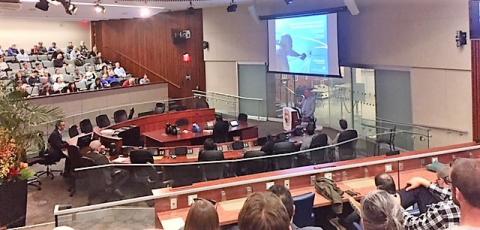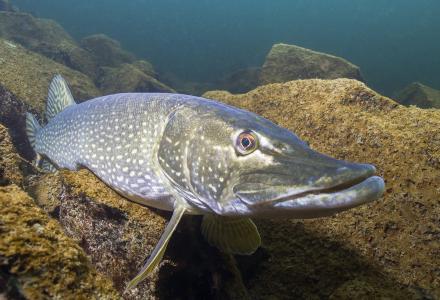
When the IJC’s Great Lakes Water Quality Board meets in various locations around the region, it strives to learn more about those communities and meet with citizens to discuss local water restoration and protection efforts.
At an evening panel discussion hosted by the board in Hamilton, Ontario, on Sept. 25, more than 100 participants learned about progress to restore Hamilton Harbour and challenges that lie ahead, as well as indigenous perspectives on ecosystem management. Earlier that day, board members toured the Six Nations of the Grand River and its drinking water treatment plant, the Hamilton Museum of Steam and Technology National Historical Site with a 150-year-old steam engine used to pump water from the harbor to city residents from the late 1850s to 1900, and the site of a multi-million dollar Randle Reef remediation site in Hamilton Harbour.

Hamilton Harbour lies at the west end of Lake Ontario, where it connects to the lake by a ship canal that runs across the sandbar that created the bay. The Hamilton watershed has been exposed to heavy industrial and urban development over the past century. Waste released into the harbor from both sources with limited or no restrictions until the early 1960s created a plethora of toxic chemicals in the sediment, including metals, polycyclic aromatic hydrocarbons (PAHs), polychlorinated biphenyls (PCBs) and others.
When the harbor was designated as an Area of Concern in 1987, it was recognized as one of the most severely polluted locations on the Canadian side of the Great Lakes. Beneficial Use Impairments included degraded fish and wildlife populations and restrictions on their consumption, algae growth, restricted water contact and beach closings.
During the evening panel presentation in Hamilton’s City Hall Council Chambers, Scott Peck of the Hamilton Conservation Authority and Chris McLaughlin of the Bay Area Restoration Council outlined several areas of progress in cleanup efforts that have occurred through partnerships and funding from local, provincial and federal governments as well as industries and other private sources. More than CDN$1.2 billion has been spent or committed to control toxic contaminants at their source, upgrade wastewater treatment plants and manage combined sewer overflows and urban stormwater. By the time Hamilton Harbour is ready for delisting in 2022 or later almost CDN$2 billion is expected to be invested in its restoration, with projected benefits by 2032 of more than $914 million to local businesses, recreational users, and local, provincial and federal governments.
One particularly expensive project is near Randle Reef, where an engineered containment facility is under development to hold severely contaminated sediments. The site is the largest contaminated sediment remediation project in the Canadian Great Lakes, with a volume large enough to contain three major hockey arenas.

The double, steel-walled sealed box will contain the most heavily contaminated sediment. Once work is completed (projected by 2022), the box will be capped and managed by the Hamilton Port Authority, which will expand and enhance its shipping piers to include the storage facility – thus generating revenue for the region. The project also will reduce the amount and spread of contaminants through the harbor, improving water quality and fish and wildlife habitat. Increased recreational opportunities will help to promote the harbor community as a progressive place to live and work.
Even with partnerships to complete remediation work in Hamilton Harbour, the costs are continuing challenges, according to Peck. “We also need to connect people to the role the harbor can play in their quality of life,” he said. The Hamilton Conservation Authority and Bay Area Restoration Council are completing small-scale restoration projects where residents will see immediate benefits, as well as projects with adults and students to engage everyone in the harbor’s restoration.
Looking beyond remediation to prevention was also a key message of the public meeting and panel discussion.
Danielle Boissoneau of the Old Turtle Clan has organized Water Walks along Hamilton Harbour and said, “We have to stop what’s creating the problem. When we spend time on the land and remember who we are, that the industrial revolution has changed our mental focus and imaginations to ones that are disconnected from the earth, then we can stop polluting our land and water.”
Water Quality Board members recognize and appreciate the importance of connecting with the local community during public meetings, and plan to continue this tradition in communities around the basin.

Sally Cole-Misch is the public affairs officer for the IJC’s Great Lakes Regional Office.



